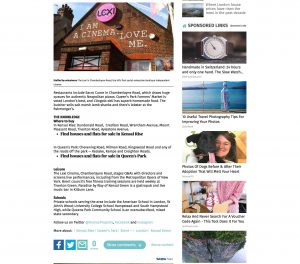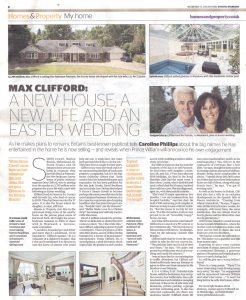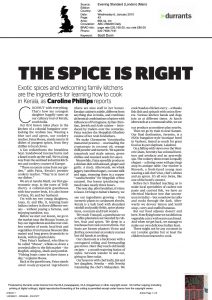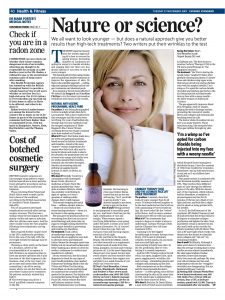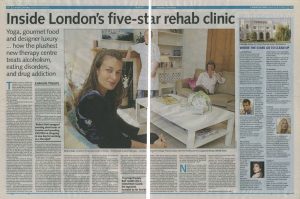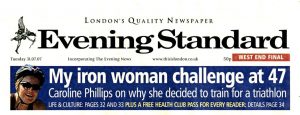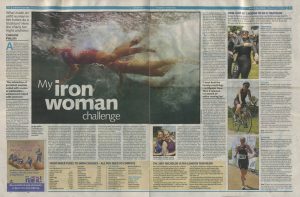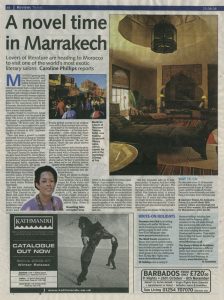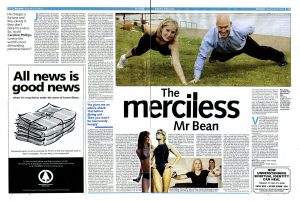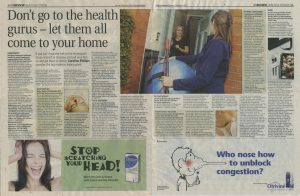A WALK around Selfridges was once my idea of aerobic exertion.
Then a few months ago my brain synapses must have got twisted, because I started working out thrice weekly.
I was able to run, say, for 40 minutes without stopping. And I was able to swim gentle lengths of breaststroke.
But when a friend suggested doing a triathlon – that’s swimming outdoors, biking and running over silly distances – I should have checked into rehab.
A WALK around Selfridges was once my idea of aerobic exertion.
Then a few months ago my brain synapses must have got twisted, because I started working out thrice weekly.
I was able to run, say, for 40 minutes without stopping. And I was able to swim gentle lengths of breaststroke.
But when a friend suggested doing a triathlon – that’s swimming outdoors, biking and running over silly distances – I should have checked into rehab.
But at the age of 47 and with two children, a mid-life crisis was looming.
Not to mention a sense (a legacy of having had an eating disorder) of never seeing myself as slim enough, plus a desire to get really fit and raise money for ChildLine.
Undeterred by my general lack of fitness, I visited Simon Costain (Paula Radcliffe’s podiatrist) who videoed me running, took a cast of my soles for orthotics and pronounced me fit to run on both feet.
I went home, signed up to Britain’s fastest- growing sport, then tripped over my own feet, damaged my coccyx and was scarcely able to move for three weeks. I felt miserable. My first challenge, a Super Sprint distance at Blenheim, was looming in June. It’s the shortest of the triathlon races ‹ 400m swim, 13.2k bike and 2.9k run ‹ but felt like an enormous goal for me.
By March I had joined the Herbalife Triathlon Training Academy ‹ which offers coaching, normally available only to the elite, to the country’s four most promising grassroots triathletes (selected from 15,000 entries) and to a few interested journalists.
At our first session, everything the mustachioed legend-cum- Olympic coach, Bill Black, said filled me with horror: the idea of jumping into murky water with hundreds of people and not having lines on a pool floor to show me where to go; the sheer distance and different disciplines to be negotiated; the amount of training to juggle with commitments to work, husband and children.
“What’s the minimum training I can do?” I asked dolefully.
“Up to you,” replied Bill, fixing his look on a man doing 15 hours a week. The experience tipped me into retail therapy at Swim Bike Run (SBR) Sports where I left £1,200 lighter and with a sexy bike.
Next I had to tackle learning to swim properly. Coach Daniel Bullock at Swim for Tri in Brick Lane’s Old
Brewery attempted to conquer my fear of swimming freestyle by filming my underwater mistakes and projecting my flailing whale impressions onto a plasma screen.
My next stop, in May, was an Academy training weekend in Eastbourne, with a clutch of superfit athletes, coach Bill and “mental performance lifestyle coach” Midgie Thompson, a sportswoman with a French manicure who helped me through some of my disheartened moments, about which more later.
As soon as we arrived we were ordered to get running. We set off like racehorses, scaling a road that was at right angles to the ground, crossing the Downs and doing a twomile loop across mountainous terrain with a gale blowing in our faces..
Puffing behind those sleek triathlon machines with a mounting sense of despair, I had the feeling that I might be about to meet my Maker.
“Imagine you have wings on you.
Where are they taking you?” panted Midgie, doing creative visualisation.
“To hell,” I replied. But I got through the run at my own pace. And afterwards I felt elated by the bracing air, endorphins and jolly company.
Afterwards we swam drills for two hours. I’d never done that much exercise in my life, but the problem with triathlon training is that you have to remember so much kit, 35 basic items, and two of us had forgotten our towels. So I dried myself with loo paper, then fell asleep at 5pm.
The exhaustion of persistent exercise that weekend ended with a sense of exhilaration ‹ achievement coupled with serotonin, I imagine. After that, I turned into a real athlete and developed a serious pill habit, popping 18 natural supplements a day, courtesy of Higher Nature. Rapidly my skin became clear, my nails and hair got stronger and my energy levels soared.
Less than two months after I had started training, I began to enjoy exercise, training nearly an hour a day, four to six times a week. I’d confide in Midgie during our phone consultations that I was too fat/ nearly 50/that everyone else would be better and faster/that I hadn’t done enough training/and that I lacked motivation. Midgie would help me turn the internal dialogue into positives: what a fantastic achievement, many younger people couldn’t do this/I’ve done ample given my other commitments.
Often I ran with my psychotherapist friend Lily, (thereby tending my madness and hamstrings simultaneously) or biked around parks.
The big day was fast approaching.
Fearing triathlon humiliation, I swam in the Serpentine amid the killer swans: triathlon lore has it that they attack swimmers. The hardy octogenarian swimmers who belong to the (self-dubbed) “Royal Serpentine Hernia Club” call the wet-besuited triathletes “Rubber Johnnies”. I loved being in the fresh air. But swimming in bird poo and looking like a wally clambering around in a wet suit in a Royal park? I hated that.
Blenheim day dawned. Midgie had agreed to run alongside me, for mental support. It was a hot day but as we descended like hundreds of rubber tadpoles into the freezing water, it took my breath away. I managed a mixture of swallowing water, panic, breast stroke and crawl. I forgot most of the techniques I’d fought so hard to learn. Midgie ploughed in front of me yelling, “Come on Caroline you can do it.” Rescue canoes came over to us three times. I was thinking, “Never again.”
But I did it! Then we reached the banks, ran up an outrageously steep hill, sped off on our bikes and pedalled furiously around Blenheim’s beautiful Capability Brown-designed landscape. The weather was perfect, the crowds supportive and, having worked so hard to get here, I had a huge sense of achievement.
After returning our bikes to the “transition” area, I ran off, losing Midgie. It didn’t matter. As I crossed the finishing line, I received a hero’s welcome. I’d finished ahead of the twentysomethings, in Olympic time. Then it dawned.
As the marshals fussed over me, I realised that I’d, er, missed out a running lap. Disqualified but not beaten, I followed Bill’s (psychologically brilliant) instructions and went back and finished the race. I still completed the course in a (very) respectable one hour 20 minutes.
There was something uplifting about showing our daughters (aged nine and 11) how anything is possible if you try hard enough..
So, now, on Saturday, I’m racing in the London Triathlon, swimming front crawl amid abandoned cars in Docklands and cycling and running over what could be several hundred miles if I get lost again.
But if all goes to plan, I’ll do a Sprint distance which is a 750m swim, 20km bike ride and 5km run.
That’ll be double what I did at Blenheim. And I hope to raise £10,000 for the NSPCC’s ChildLine services. I feel proud that, with the help of my younger brother, Simon, I’ve already raised £5,000.
Looking back, I’ve loved my recent training, and its intensity, have enjoyed meeting triathletes and have revelled in my new-found focus, positivity and energy. I’ll miss having a goal and feel out of sorts on days when I don’t exercise.
But I feel apprehensive about the race. I feel scared that I may be unable to complete the swim. (After all, it is the equivalent of 30 lengths of a 25m pool). And I feel nervous that I may not be able to manage a run after all that biking and swimming.
But that’s how I felt before Blenheim. Anyway I don’t have to be fast. I’d just like to finish the race.
So if you see number 3433 getting lost, point me in the right direction.
To sponsor Caroline go to www.justgiving.com/carolinephillips
FROM INNER TUBES TO SWIM COACHES – ALL YOU NEED TO COMPETE
THE KIT
>From SBR Sports (01753 830118, www.sbrsports.com) LeMond Etape bike £600 Helmet £49.99 Pedals £9.99 Bottle cage £7.99 Pump £12.99 Bike computer £34.99 Saddle bag £12.99 Inner tube £4.99 Tyre levers £2.99 Orca Tri top and pants £80
Race belt £5.99 Elastic laces £5.99 Asics trainers £85 Bottle £3.50 Orca wetsuit £250 Turbo trainer £179 Kryptonite bike lock £29.99 Cycling glasses £29.99 Anti-blister socks £12.99 Rehydration tablets £4.99/pack Natural supplements from Higher Nature £55 per week (0800 458 4747; www.highernature.co.uk )
THE SUPPORT
Olympic coach Bill Black, www.billblackcoaching.com, prices from £60 an hour.
Midgie Thompson, mental performance and lifestyle coach, www.brightfuturescoaching.com, £100 an hour.
John Beaton, masseuse at the Harbour Club, www.harbourclub.co.uk, £45 an hour..
Daniel Bullock at Swim for Tri, www.swimfortri.com, first consultation £75; thereafter £50 an hour.
HALF TRIATHLON ENTRY COSTS
London: £69 Blenheim: £59 Royal Serpentine Swimming Club: membership £20
THE 2007 MICHELOB ULTRA LONDON TRIATHLON
THE London Triathlon is a great two-day event for spectators. Held in and around ExCeL in London’s Docklands (take the Docklands Light Railway to Custom House), it attracts more than 12,000 people competing in the world’s largest triathlon. There are a variety of locations for the expected 45,000 spectators ‹ some under cover ‹ and a big screen in the ExCel centre, not to mention restaurants and dockside cafes.
Saturday is for the amateurs like myself who are competing in the half-triathlon ‹ catch me and 430 others in the Female Sprint Group 2 starting at 2.30pm..
On Sunday, world-class athletes including current World Champion Tim Don and Olympic silver medalist Bevan Docherty will be vying for the fastest times in the full Olympic triathlon which requires a 1.5km open-water swim, 40km bike ride and 20km run.
For those wanting a break from trying to glimpse their loved ones whizzing past, there will also be a huge Expo held in the main hall with retailers such as SBR Sports and professionals on hand to help anyone keen to learn more about the UK’s fastest growing sport ‹ triathlons.
www.thelondontriathlon.com
HOW I GOT FIT ENOUGH TO DO A TRIATHLON
When I started triathlon training, my coach Bill told me that if I could do the distance in each discipline individually, then I could do the whole thing. I found this very motivating. Here is how my fitness was transformed in under four months:
SWIMMING
Before Although I could do a mile in breaststroke, when feeling fit, I’d never mastered front crawl, or freestyle as it’s referred to by triathletes.
During You need to be able to do front crawl for triathlons, especially in a wetsuit, which doesn’t lend itself to breaststroke. I took lessons with Swim For Tri at the Old Truman Brewery and was talked through the correct technique before trying it in front of my coach, who corrected me until I could stay afloat. Then I went off to try it out on my own.
I practised at least once a week at my local baths, and attended four Swim For Tri sessions. An underwater camera recorded my style, which was then critiqued by experts. Then I went in the endless pool ‹ swimming against an adjustable current ‹ while adjusting my style for maximum performance.
Once a week I went to Kensington Leisure Centre, where I repeated exercises to improve my stroke. I swam alongside a woman who’d just swum round Alcatraz, and another who’d completed the Iron Woman Challenge. They were supportive.
To acclimatise and build confidence for swimming across open stretches I did laps of the Serpentine.
Now This week I completed an hour of drills, breaking for only a few seconds between 100m sprints. Recently I did a two-hour freestyle swimming session ‹ with short breaks..
CYCLING
Before I didn’t even own a bike. Occasionally I’d borrow my 11-year-old daughter’s bicycle to do the school run ‹ on the pavement. I never cycled for exercise.
During I started with the attitude that “anyone can cycle”, which may not have been sensible, but it made the task ahead less intimidating.
In April, on a sleek lightweight bike, I discovered that racing tyres have no proper grip. I struggled through a rain-sodden two-hour training ride, finding out that you get cold when you stop, so it’s better to soldier on.
At first my training schedule was virtually nonexistent.
I only wanted to cycle on pavements and paths, so lengthy stamina-building road training didn’t appeal. Instead I visited the country every three weeks and cycled downhill on country lanes for an hour. My theory was that I could build up resistance through running and swimming.
Recently I began longer, more serious cycles, doing circuits of Regent’s Park and Richmond Park with a friend’s husband.
Two weeks ago I even took a 45-minute spin class at my gym ‹ now that was seriously tough.
Now I can cycle like a pro for 90 minutes on my lovely LeMond bike..
RUNNING
Before I’d started running about a year and a half before deciding to compete in a triathlon. So, when the training began I could run for a respectable 40 minutes, which I did two or three times a week through Hyde Park or Kensington Gardens.
During My real training began in March. I joined the Herbalife Triathlon Training Academy where Bill told me it’s possible to train for a short triathlon, such as the Blenheim Sprint, in just six to eight weeks.
In May I went off to a two-day workshop in Eastbourne which involved running gruelling twomile circuits. It was an intensive experience, but if anything I found it more terrifying than inspiring.
Bill sent me precise training schedules, which I was to follow week by week, gradually building up my running distance. But instead of sticking to his regime, I trained at my own pace.
Every week I made sure I did at least one long run, for at least an hour. When my sister-in-law accompanied me, she brought an athlete’s flak jacket to weigh me down. I still managed to complete the run. Each week I made sure to have at least one day’s rest. You improve a lot by letting your muscles relax.




